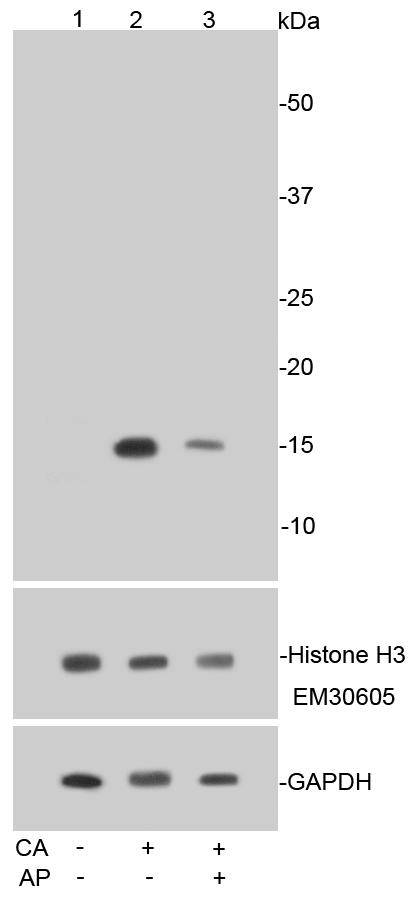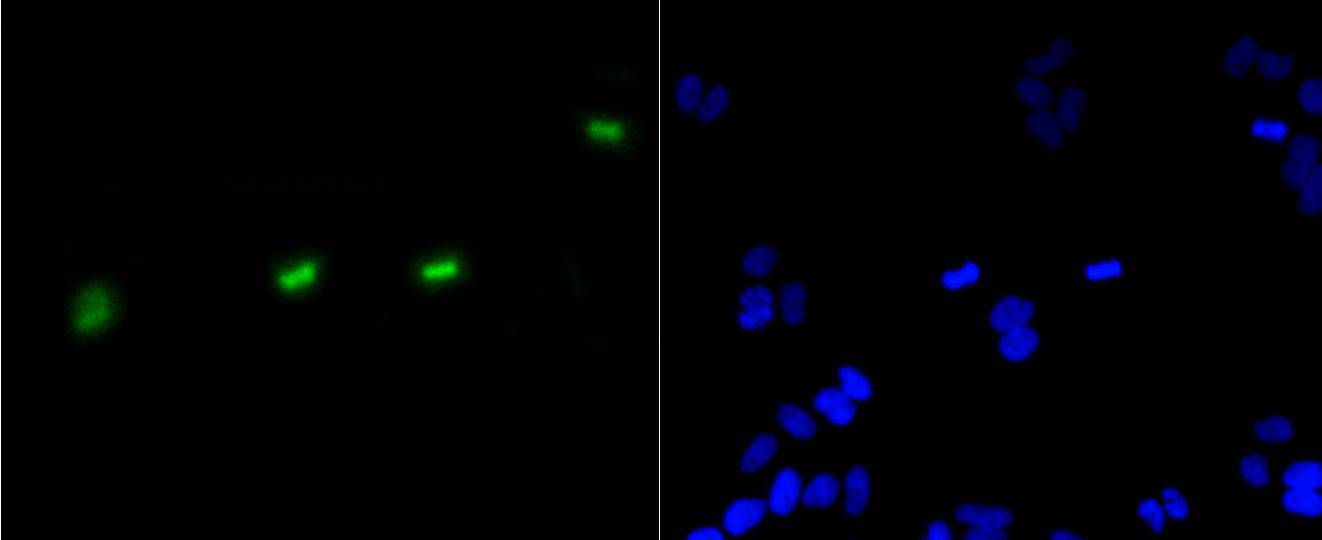Product Name :
Histone H3 (Phospho-S10) polyclonal antibody Background :
In eukaryotes, DNA is wrapped around histone octamers to form the basic unit of chromatin structure. The octamer is composed of histones H2A, H2B, H3 and H4, and it associates with approximately 200 base pairs of DNA to form the nucleosome. The association of DNA with histones results in dense packing of chromatin, which restricts proteins involved in gene transcription from binding to DNA. Histone H3, the core protein of the nucleosome, becomes phosphorylated at the end of prophase. The two major sites of phosphorylation are the mitosis-specific site Ser10, and Ser28, both of which are extensively phosphorylated in DNA-bound forms of histone H3 and in nucleosomal histone H3. The nucleosome structure of histone H3 promotes N-terminal phosphorylation in vitro. Product :
Rabbit IgG, 1mg/ml in PBS with 0.02% sodium azide, 50% glycerol, pH7.2 Storage&Stability :
Store at +4°C after thawing. Aliquot store at -20°C or -80°C. Avoid repeated freeze / thaw cycles. Specificity :
Histone H3 (Phospho-S10) polyclonal antibody detects endogenous levels of Histone H3 protein only when phosphorylated at S10. Immunogen :
Synthetic phospho-peptide corresponding to residues surrounding Ser10 of human Histone H3. Conjugate :
Unconjugated Modification :
Phosphorylation
Histone H3 (Phospho-S10) polyclonal antibody Background :
In eukaryotes, DNA is wrapped around histone octamers to form the basic unit of chromatin structure. The octamer is composed of histones H2A, H2B, H3 and H4, and it associates with approximately 200 base pairs of DNA to form the nucleosome. The association of DNA with histones results in dense packing of chromatin, which restricts proteins involved in gene transcription from binding to DNA. Histone H3, the core protein of the nucleosome, becomes phosphorylated at the end of prophase. The two major sites of phosphorylation are the mitosis-specific site Ser10, and Ser28, both of which are extensively phosphorylated in DNA-bound forms of histone H3 and in nucleosomal histone H3. The nucleosome structure of histone H3 promotes N-terminal phosphorylation in vitro. Product :
Rabbit IgG, 1mg/ml in PBS with 0.02% sodium azide, 50% glycerol, pH7.2 Storage&Stability :
Store at +4°C after thawing. Aliquot store at -20°C or -80°C. Avoid repeated freeze / thaw cycles. Specificity :
Histone H3 (Phospho-S10) polyclonal antibody detects endogenous levels of Histone H3 protein only when phosphorylated at S10. Immunogen :
Synthetic phospho-peptide corresponding to residues surrounding Ser10 of human Histone H3. Conjugate :
Unconjugated Modification :
Phosphorylation
-
 Western blot analysis of Phospho-Histone H3(S10) on Hela cell lysates using anti-Phospho-Histone H3(S10) antibody at 1/1,000 dilution. Positive control: Lane 1: Untreated HeLa cell lysate Lane 2: HeLa cell lysate treated with calyculin A Lane 3: HeLa cell lysate treated with calyculin A and alkaline phosphatase
Western blot analysis of Phospho-Histone H3(S10) on Hela cell lysates using anti-Phospho-Histone H3(S10) antibody at 1/1,000 dilution. Positive control: Lane 1: Untreated HeLa cell lysate Lane 2: HeLa cell lysate treated with calyculin A Lane 3: HeLa cell lysate treated with calyculin A and alkaline phosphatase -
 ICC staining Phospho-Histone H3(S10) in Hela cells (green). The nuclear counter stain is DAPI (blue). Cells were fixed in paraformaldehyde, permeabilised with 0.25% Triton X100/PBS.
ICC staining Phospho-Histone H3(S10) in Hela cells (green). The nuclear counter stain is DAPI (blue). Cells were fixed in paraformaldehyde, permeabilised with 0.25% Triton X100/PBS.
Bioworld Biotech only provide peptides for our antibodies and do not provide additional peptide customization services.
Price/Size :
USD 368/1mg/vial
Tips:
For phospho antibody, we provide phospho peptide(0.5mg) and non-phospho peptide(0.5mg).Describe :
Blocking peptides are peptides that bind specifically to the target antibody and block antibody binding. These peptide usually contains the epitope recognized by the antibody. Antibodies bound to the blocking peptide no longer bind to the epitope on the target protein. This mechanism is useful when non-specific binding is an issue, for example, in Western blotting (WB) and Immunohistochemistry (IHC). By comparing the staining from the blocked antibody versus the antibody alone, one can see which staining is specific; Specific binding will be absent from the western blot or IHC performed with the neutralized antibody.Formula:
Synthetic peptide was lyophilized with 100% acetonitrile and is supplied as a powder. Reconstitute with 0.1 ml DI water for a final concentration of 10 mg/ml.The purity is >90%,tested by HPLC and MS.
Storage:
The freeze-dried powder is more stable. For short time at 2-8°C. For long term storage store at -20°C.
Note :
This product is for research use only (RUO only). Not for use in diagnostic or therapeutic procedures.
 Histone H3 (Phospho-S10) polyclonal antibody
Histone H3 (Phospho-S10) polyclonal antibody  Datasheet
Datasheet COA
COA MSDS
MSDS SHIP
SHIP